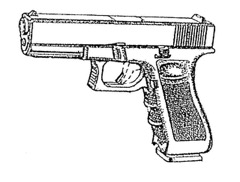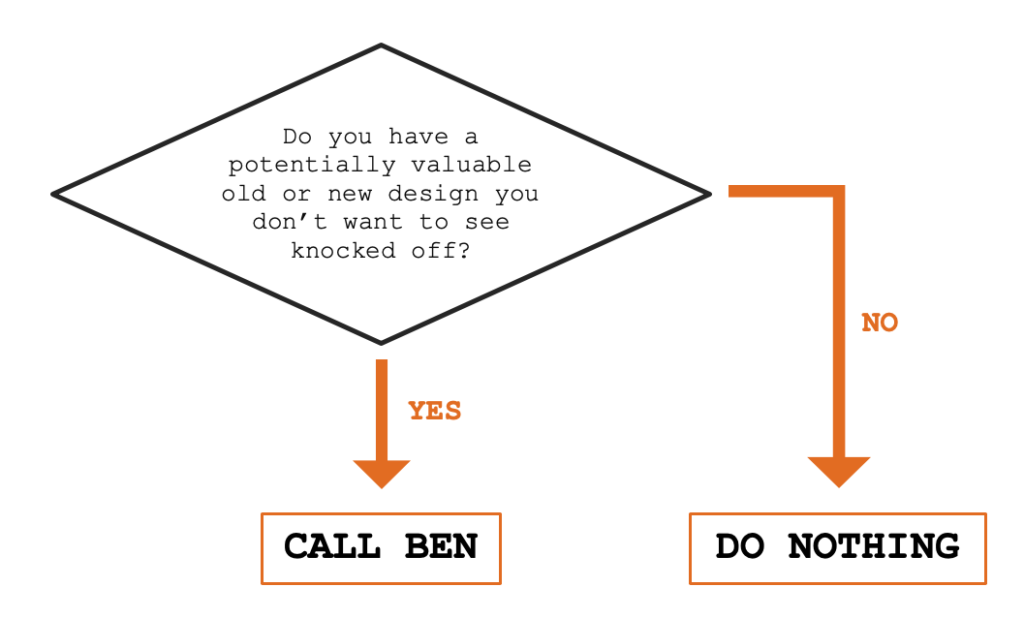By Ben Langlotz
|
June 12, 2023
|
Books & Resources, Business, Copyright, Firearms, Firearms Industry Advice, How To, Intellectual Property Advice, Legal News, Marketing, Patent, Trademark
|
0 Comments
HOW TO PROTECT “COOL”…
TWO FAMILIAR WAYS TO PROTECT PRODUCT DESIGNS, PLUS A THIRD WAY YOU’VE NEVER HEARD OF AND CAN UNDOUBTEDLY AFFORD.
Everyone wants a patent.
It’s perfectly logical to want to protect a new product. Technical innovations help set you apart in a crowded marketplace and a patent prevents anyone else from offering your innovation for 20 years.
But let’s be honest, not every new product has patentable technical innovations. Sometimes, what makes a successful product isn’t how it works or what it does, but how it looks. Style sells, and something that looks cool to your customers can stand apart on the shelf from the competition. Consider the last time you purchased a pistol – you might have compared specs and comfort, but I’ll bet you didn’t buy the one that you thought looked wrong (which to you might mean ugly, trendy, wimpy, etc.) It’s the same when you buy a new vehicle, or blue jeans. Even the curmudgeons who claim that they’re purely rational, practical, and analytical in their choices, and are unaffected by emotion and aesthetics are the same – they just pick the style with the design cues that convey practicality – a Hummer over a Hyundai.
Probably the best indicator on whether designs are worth protecting is whether they are being knocked off. You know who you are. Whether it’s a direct competitor, a Chinese import on Ebay, an Airsoft replica, or an image in a video game, you know when you’re being knocked off. If you don’t have a regular (“utility”) patent on some nifty functional aspect, your only way to protect against knockoffs is to protect the design.
Design Patents – Act Fast!
If you have a new or upcoming product with a distinctive design, then design patent protection is always our first consideration. The big challenge is that too often when my clients come to me realizing that they have a valuable design, it’s too late. A design patent application must be filed within six months of product release (or certain other commercial activity). No provisionals to buy time, no 12-month grace period like utility patents. As a rule you’re making design patent investment decisions before you have any product or design feedback from customers or reviewers.
If your product is heavily design dependent, like a pistol that will inevitably have its own distinctive form and look, then design patents are probably ideal.
The average cost to get to a granted design patent is maybe 1/4 the cost of a utility patent. Examination isn’t quite a rubber stamp, but rejections are the exception, and usually low cost to address. Confidence is high that a design patent will be granted in most cases, with little if any cost beyond the filing costs. That includes maintenance fees – there aren’t any. But your design patent expires in 14 years, so a long-life product may face knock-offs sooner than you’d like. And that low cost isn’t always quite cheap enough if you’re producing dozens of low-volume designs per year to keep a fresh array of new products.
A pending design patent application enables you to properly say “Patent Pending” and leave your competitors wondering if you have a utility patent application pending (which you may, some products have both patentable functional features and patentable non-functional designs).
Trade Dress – Superstars Only, Please
Trade dress is simply a trademark on a product shape that is so recognized it acts like a trademark even without any other branding. Classic examples are the Coca-Cola bottle and Chanel Perfume bottle.
Here’s another one:

How about this?:

Note that to get that Glock pistol trade dress registered, the record shows 38 documents back and forth with the U.S. Patent and Trademark Office over nearly three years, including an appeal. Trade dress registration isn’t usually fast, easy, or cheap.
But it’s forever. Once registered, a renewal filing every decade is inexpensive and tolerable. If Glock had applied for a design patent back when they applied for this trade dress, it would have expired five years ago.
The biggest hurdle to this valuable trade dress protection is recognition in the marketplace. It’s not enough to be distinctive or creative. It must be recognized so well that a man-on-the-street survey (at least among your typical customers) would yield proof that the design was recognized. In most cases the answer to the question of whether your design might be eligible for trade dress protection is: “Not yet.”
And in most cases, the answer is “never” because only a minuscule fraction of designs end up achieving the recognition it takes to earn enforceable protection.
Clearly, if you need to wait years until a design finally earns consumer recognition, then the silver lining is that it’s never too late. There is no pressing deadline like for design patent applications.
Copyright – (I’m trying not to call it “Poor-Man’s Design Protection”)
Smart-Man’s Design Protection?
Copyright is for things like books, songs, recordings, videos, and artwork including… sculptures. Hmm…
I see lots of beautiful gun products I’d say qualify as works of art. Could these be protected like an artist’s sculpture? The answer is yes – maybe.
The first catch is that copyright doesn’t apply to functional works. That means that the overall product shape (like the form of a pistol) is probably not a good candidate. But copyright is great for decoration. This might include distinctive ventilation hole patters in a handguard, a new pattern of serrations on a pistol slide, or fluting patterns on a barrel. It might well include that distinctive little design element on the side of the pistol that makes a nice transition from one surface to another. I’m thinking about those AR magwells that look like a skull – good candidates for sculptural copyright.
These limits might sound overly strict, but my experience is that these are the types of designs than my clients are usually asking about protecting, especially after it’s too late for a design patent.
Cost is often another factor. If a company is producing dozens of different slide serration and contour designs each year, even “affordable” design patent protection leaves them with a six-figure annual design protection bill that might not be justified as an investment – they can’t know in time which might be the hit sellers. But cut that budget by maybe a quarter (we’re now into sales tax territory compared to a utility patent) and knock-off protection for the portfolio can make sense.
In general, with copyright protection the expiration is 120 years (when the creator is a corporation), and 70 years beyond the death of an individual “sculptor.” May as well be forever.
One reality of any kind of design protection is the narrowness of the protection. Design patents and Trade Dress focus more on the overall similarity, but copyright is about copying. Even an alternative design independently created to resemble your protected design might avoid infringement. But odds are you’re more worried about direct knock-offs than about determined design efforts by competitors. Certainly, Airsoft makers strive for lookalike status to sell their products, and your copyrighted design is something they’d rather pay to license to get perfectly right.
Besides the low cost (down in simple word trademark territory), another nice thing about a copyrighted design is that you have something to enforce. If there’s a Chinese knockoff sitting on Cabela’s shelves, their legal department might ignore a complaint letter. But if we enclose a copyright registration with our cease and desist letter, they’re more likely to yank the infringing product and let their supplier worry about it.
Timing is a factor in copyright. While we can get a copyright registration much later, after you realize a design is valuable (usually when the knock-off crops up) there are great advantages to registering early. If you register too late, you can still get actual damages, but these require a protected lawsuit to determine. If we always file within three months of the “publication” (product release), then you’re eligible for “statutory damages”. These are the big sharp “teeth” of copyright law.
This can mean $750-$30,000 per work infringed, potentially even per infringement. If your product made it clear that it was copyrighted then it may be considered “willful” (not innocent) infringement, giving statutory damages up to $150,000 per work. We’re talking real money here.
And so you know this is for real, one of my prominent widely-respected clients some years ago had a lazy web person swipe a photo from another website and use it on the client’s website. Oops! That can’t cause much damage – just remove and apologize, right? Sorry, but statutory damages meant that my client wrote a five-figure check to make this go away. Teeth.
And even if you have designs that have been out more than three months, the good news (unlike the strict deadline of design patent law) is that if you get your copyright applications filed before infringers arise, you get the same “toothy” statutory damages. This means not only is it never too late, but also that it’s never too soon.
Now, you’re probably thinking to yourself upon reading that last paragraph: “So Ben, that would seem to suggest that maybe the best time to go through my entire product line looking for copyrightable designs might be…NOW?”
And you’d be correct. If you want until after an infringer arises, you’re essentially toothless. If we start now, you can have a solid portfolio that will make infringers regret they ever tangled with you.
PS: All this applies to registering your other creations that might be copied, including website, photos, manuals, ad copy, etc.
Cut to the Chase – Executive Summary
Design Patents
Pros:
- Fairly easy to get
- Much cheaper than utility patents
- Give you “Patent Pending” status to make your competitors worry
- No renewal or maintenance fees
Cons:
- RUSH! It might already be too late. Must file within 6 months of product release
- Moderate cost, but not cheap if you have a multitude of designs per year
- Expire in 14 years
Trade Dress (Design Trademarks)
Pros:
- Trademarks are forever – they never expire
- It’s never too late – Available for old, mature, long-released products.
Cons:
- Only for the most recognized and established “crown jewel” designs. Not for most new products.
- High standard of proof may require expensive survey evidence.
- Expensive uphill battle. Longshot for typical designs
Copyright
Pros:
- CHEAP to get, and no renewal costs
- Powerful enforcement teeth
- They last (nearly) forever – guaranteed to outlive you!
Cons:
- Good for applied artwork, decoration, but not for overall product design
- Narrow – good only for lookalikes and copies and not merely similar designs
- Fast action required to get enforcement teeth – little time to decide
Design protection decision flow chart
I was going to create a flow chart that provided a decision tree to help you determine the right kind of design protection. It was going to ask about how recognized and recent the product might be, how valuable to you, how long of a life cycle, and other factors. But I realize that you probably have better things to do, so I offer this far more useful flow chart:
